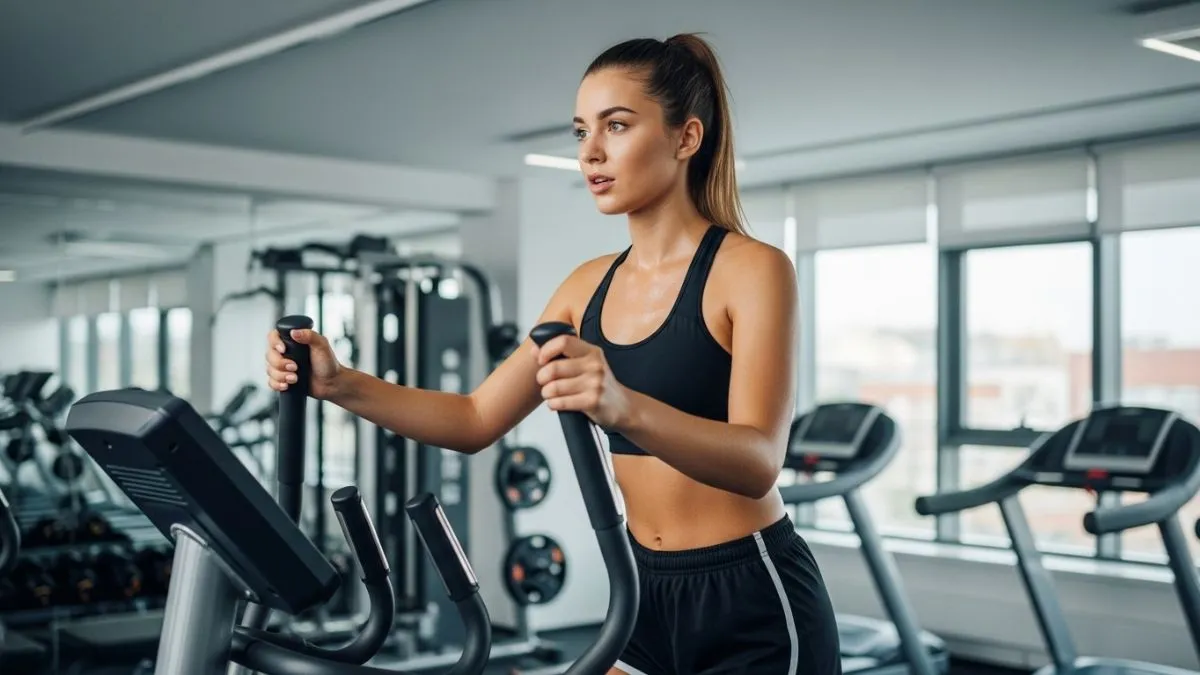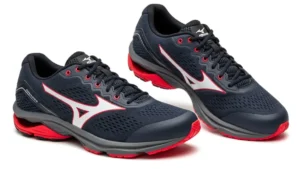
A cross trainer is good for weight loss, strength, and stamina because it works both upper and lower body while staying gentle on the joints. On average, you can burn 250–400 calories in 30 minutes depending on weight and intensity, making it a safe and effective choice for all fitness levels.
If you’ve ever wondered whether a cross trainer is just another piece of gym equipment or something that can truly improve your health, this article clears it up. You’ll see how it helps with weight control, builds strength, improves heart health, and protects your joints at the same time.
What Is a Cross Trainer?
How a Cross Trainer Works
A cross trainer works by combining arm and leg movement with adjustable resistance, giving you a full-body workout. Your arms push and pull the handles while your legs move in an elliptical path, reducing stress on the joints. This coordinated action strengthens muscles, burns calories, and supports better stamina.
Think of it as walking, running, and climbing stairs rolled into one smooth motion. The pedals move in a continuous oval, and the handlebars keep your upper body active. Resistance levels can be increased to mimic uphill climbs, building both strength and endurance.
Cross Trainer vs Other Cardio Machines
A cross trainer offers a joint-friendly, full-body workout, while treadmills mainly target the legs, bikes focus on lower body endurance, and rowing machines emphasize back and arms. This makes the cross trainer one of the most balanced cardio machines for all-around fitness.
Unlike a treadmill, it doesn’t pound the knees. Compared to a stationary bike, it engages your arms as much as your legs. While rowing strengthens the back, it can strain posture if not done correctly. A cross trainer balances intensity and safety, making it suitable for both home and gym users.
Key Cross Trainer Benefits
Full-Body Workout
A cross trainer works both upper and lower body at the same time. Your legs push and glide, your arms drive the handles, and your core stabilises every movement. This coordination targets major muscles including quads, hamstrings, glutes, chest, back, shoulders, and abs in one smooth workout.
This makes it efficient for anyone short on time but wanting maximum muscle activation. Unlike machines that isolate one area, the cross trainer keeps multiple muscle groups engaged without overloading them.
Low-Impact Exercise for Joints
A cross trainer is safe for knees, hips, and ankles because the pedals move in a smooth, elliptical path without pounding the joints. This makes it ideal for people with arthritis, past injuries, or those who can’t handle the stress of running.
The machine mimics natural walking motion while keeping your feet grounded, reducing shock by up to 70% compared to running on a treadmill. Many physiotherapists recommend it for safe recovery exercise.
Supports Weight Loss Goals
A cross trainer helps with weight loss by burning 250–400 calories in 30 minutes, depending on body weight and intensity. This makes it one of the most efficient cardio machines for steady fat loss while also building endurance.
Since it engages more muscles than a bike or treadmill, calorie expenditure stays higher for the same workout time. Increasing resistance or speed pushes the burn even further.
Improves Heart and Lung Health
Using a cross trainer strengthens the heart and lungs by keeping you in aerobic and anaerobic heart rate zones. Regular sessions boost cardiovascular fitness, lower resting heart rate, and increase oxygen uptake (VO2 max).
Even 20–30 minutes of moderate effort improves circulation and helps regulate blood pressure. Over time, your stamina grows, allowing you to train harder without fatigue.
Builds Strength and Endurance
The resistance settings on a cross trainer build muscle tone while also improving stamina. Pushing against higher resistance strengthens legs, arms, and core, while longer sessions expand endurance over weeks.
Think of it like climbing a hill: the more resistance you add, the stronger your muscles adapt. Progressive overload—gradually increasing resistance and time—makes it a tool for both strength and conditioning.
Suitable for All Fitness Levels
A cross trainer works for beginners, seniors, and athletes alike because resistance and pace can be adjusted to match ability. It’s low-impact, easy to learn, and flexible for different fitness goals.
Whether you’re recovering from injury, starting out, or training at a high level, you can scale workouts to your needs. That’s why gyms and physiotherapy centers keep them as a standard option.
Key Cross Trainer Benefits
Full-Body Workout
A cross trainer works both upper and lower body in one session. Your legs push through the pedals, your arms pull and push the handles, and your core stays engaged for balance. This combination targets legs, arms, chest, back, and abs, giving you more muscle activation than most cardio machines.
It’s like blending cycling with arm training in a single motion. By engaging multiple muscle groups, you burn more calories and build balanced strength without needing several machines.
Low-Impact Exercise for Joints
A cross trainer is safe for knees because the pedals follow a smooth elliptical path that avoids the pounding impact of running. This makes it suitable for people with arthritis, past injuries, or anyone wanting cardio without joint stress.
Unlike treadmills, your feet never leave the pedals, so pressure on knees, hips, and ankles drops sharply. Many physiotherapists recommend it as a safe recovery tool.
Supports Weight Loss Goals
A cross trainer burns 250–400 calories in 30 minutes depending on body weight and workout intensity. That makes it an efficient machine for weight loss while also improving endurance and strength.
Since it activates both upper and lower body, calorie burn is often higher than cycling and close to running but with less strain. Pushing harder with intervals or resistance can drive calorie burn up even further.
Improves Heart and Lung Health
A cross trainer strengthens the heart and lungs by keeping you in aerobic and anaerobic heart rate zones. Regular use increases oxygen capacity, lowers resting heart rate, and improves circulation, which are key signs of stronger cardiovascular fitness.
Even 20–30 minutes of steady effort trains the heart to pump more efficiently. Over time, your breathing improves and stamina rises, allowing you to exercise longer without tiring.
Builds Strength and Endurance
The resistance settings on a cross trainer build muscle tone while extending stamina. Pushing against resistance strengthens legs, arms, and core, while longer workouts improve endurance over weeks of training.
It’s similar to climbing hills — the higher the resistance, the harder your muscles adapt. By gradually adding resistance or workout length, you achieve progressive overload, a proven method for building strength and stamina together.
Suitable for All Fitness Levels
A cross trainer fits beginners, seniors, and athletes because speed and resistance can be adjusted to match ability. Its low-impact design makes it safe for joints, while the workout intensity can scale from light cardio to challenging endurance training.
This flexibility is why it’s common in both gyms and rehabilitation programs. From casual users to competitive athletes, it adapts to each person’s goals.
Practical Tips for Getting the Most Out of a Cross Trainer
Warm-Up and Cool-Down
Warming up before a cross trainer session prepares your muscles and joints, while cooling down helps your body recover and lowers heart rate safely. Skipping these steps increases the risk of stiffness, soreness, and injury, especially during longer or more intense workouts.
A 5-minute warm-up at low resistance followed by a 3–5 minute cooldown keeps your workouts safe and more effective.
Interval Training for Faster Results
Interval training on a cross trainer alternates short bursts of high intensity with recovery periods. This method burns more calories in less time, boosts stamina, and keeps workouts engaging. A 20-minute interval plan often outperforms steady cardio for fat loss and fitness.
For example: try 1 minute of high resistance, followed by 2 minutes of easier pace, repeated several times. This style of training challenges both strength and endurance.
Adjusting Resistance and Incline
Increasing resistance and incline safely builds stamina and strength by making your muscles work harder without straining joints. Keeping changes gradual avoids overtraining and supports steady improvement.
Start with low resistance to master the motion, then add levels slowly each week. This progressive approach keeps workouts challenging and prevents plateaus.
Tracking Progress
Tracking your progress on a cross trainer using a fitness tracker or built-in monitor helps you stay motivated and measure real improvements. Watching calories burned, heart rate, and session length makes it easier to set and reach goals.
Even small wins like longer sessions or higher resistance add up over time. Consistent tracking also prevents guesswork and shows where you need to push harder.
Final Thoughts
A cross trainer is one of the most practical fitness machines for boosting health, building strength, improving stamina, and protecting joints. Its full-body motion, calorie-burning potential, and low-impact design make it safe, effective, and accessible for all fitness levels, whether at home or in the gym.
FAQs
Is a Cross Trainer Better Than Running?
A cross trainer is safer for joints than running because there’s no impact, while calorie burn can be similar depending on intensity. Running generally burns slightly more calories per minute, but the cross trainer offers a joint-friendly, full-body workout that makes it more suitable for long-term use.
Can You Build Muscle With a Cross Trainer?
A cross trainer helps tone muscles but doesn’t build large muscle mass like weightlifting. It strengthens legs, arms, back, and core through resistance, but it won’t trigger hypertrophy, the process needed for muscle growth.
How Often Should You Use a Cross Trainer?
Using a cross trainer 3–5 times per week for 30–45 minutes is recommended for most people. This frequency supports weight loss, cardiovascular health, and endurance without causing overtraining or joint stress.
Is It Good for Seniors?
A cross trainer is excellent for seniors because it’s low-impact, easy on the joints, and adjustable to match fitness level. It allows safe cardiovascular exercise without the risk of falls or heavy joint stress.
Does It Help With Belly Fat?
A cross trainer helps reduce belly fat by burning overall calories, but it doesn’t target fat in just one area. Spot reduction isn’t possible, but steady calorie burn paired with a healthy diet leads to total body fat loss, including around the midsection.







